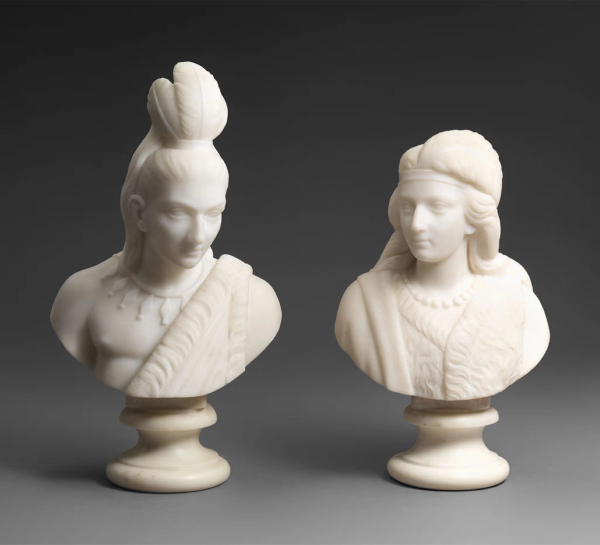Hiawatha
Artwork Details
- Title: Hiawatha
- Artist: Edmonia Lewis (American, 1844–1907)
- Date: 1868
- Geography: Made in Rome, Italy
- Culture: American
- Medium: Marble
- Dimensions: 13 3/4 × 7 3/4 × 5 1/2 in. (34.9 × 19.7 × 14 cm)
- Credit Line: Morris K. Jesup and Friends of the American Wing Funds, 2015
- Object Number: 2015.287.1
- Curatorial Department: The American Wing
Audio

Edmonia Lewis’s Hiawatha & Minnehaha | Gallery 759
An art historian tells the story of how a talented artist and savvy businesswoman rose to prominence after the Civil War.
LISA E. FARRINGTON: We’re looking at two marble busts about half life sized by Edmonia Lewis, who was an African and Native American sculptor thriving in the second half of the nineteenth century.
KATY HESSEL: That’s art historian Lisa Farrington. These two sculptures of Native American figures—Minnehaha and Hiawatha—are chiseled with incredible skill and restraint. When Edmonia Lewis was working just after the Civil War, the wealthy white elites of the art world did not believe that she was capable of creating such work as a woman of color.
FARRINGTON: People questioned Edmonia Lewis’s ability to be a neoclassical sculptor working in heavy hard stone like marble
And so she had to show people that it was she who was sculpting.
She’d hammer and chisel everything, often in front of audiences, to prove that she was not a hoax.
HESSEL: White Americans came into her studio in Rome to watch her as she worked, and they became enamored with her marble sculptures, purchased them, and exhibited them back in America.
FARRINGTON: And I’m speechless really when I think about how she was able to succeed. Sculpting in marble is not cheap. The marble cost a small fortune and she had issues with debts that she had to pay and so she couldn’t just be a sculptor. She had to be a serious businesswoman.
I wish that she had written something about her thought processes, because how does one do that in that age?
HESSEL: Unfortunately, her success didn’t last long. It’s only within the last fifty years that works like these incredible busts in The Met have gained more attention. Art historian Lisa Farrington has a fascinating story of how Edmonia Lewis’s work became more well known.
FARRINGTON: Her Cleopatra, 1876, larger-than-life-size marble sculpture, was rediscovered. At the time, in the 1870s. It was purchased by a wealthy man—one of his horse’s names was Cleopatra. And he purchased Cleopatra from Edmonia Lewis as a headstone for his horse’s grave. Now, literally a hundred years go by and things happen. The gravesite is abandoned. There’s this sculpture sitting there for a hundred years that nobody ever moved because it, you know, it weighs tons.
And a fire marshal coming to inspect the area found it and he saw at the very bottom it said E. Lewis Roma and he galvanized a few people to clean it up and eventually the Smithsonian got involved and realized what it was—that it was this sculpture by Edmonia Lewis that had been waiting for a hundred years to be rediscovered.
After that, her popularity shot through the roof. All of a sudden she’s showing up in all of the textbooks. The recovery of that sculpture was in the national press. So there you go. She’ll never be forgotten again, at least no time soon.
HESSEL: Listen on to hear more incredible stories about women artists at The Met.
Listen to more about this artwork
More Artwork
Research Resources
The Met provides unparalleled resources for research and welcomes an international community of students and scholars. The Met's Open Access API is where creators and researchers can connect to the The Met collection. Open Access data and public domain images are available for unrestricted commercial and noncommercial use without permission or fee.
To request images under copyright and other restrictions, please use this Image Request form.
Feedback
We continue to research and examine historical and cultural context for objects in The Met collection. If you have comments or questions about this object record, please contact us using the form below. The Museum looks forward to receiving your comments.